by Matt Corrion
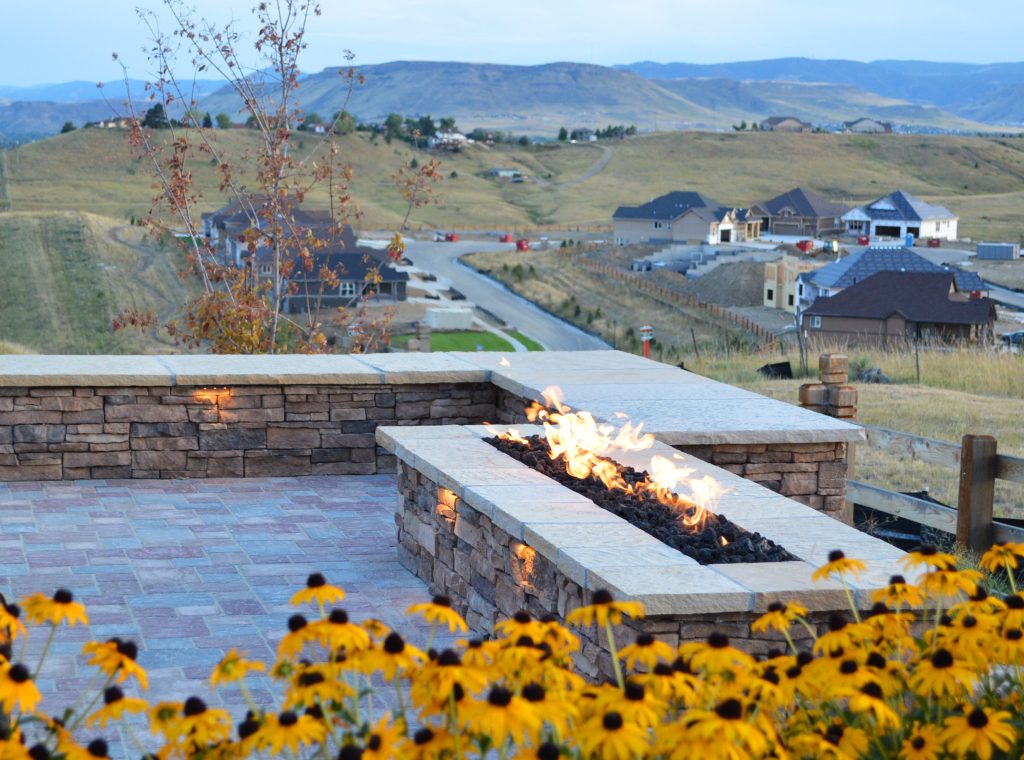
The landscape design includes patio space and a gas fire pit that allows easy enjoyment of the mountain views
Are you considering purchasing a new home? When you tour the lot, examine the adjacent views and how the site may be landscaped and used for outdoor living space. With a little foresight and a good design, the yard can be made into an inviting extension of your home for your family and guests alike.
For this project, located on the west side of Arvada, Colorado, we worked with the homeowners to take advantage of amazing mountain views, while adding value and convenience to their property. A sloped lot was redesigned to provide a flat lawn area and a secondary seating area with a custom gas fire pit. Pavers were used to soften the existing covered concrete patio, and a built-in outdoor kitchen and bar seating were added. Soft lighting provides security and ambiance in the evening, while the Rocky Mountains provide the backdrop for stunning sunsets.
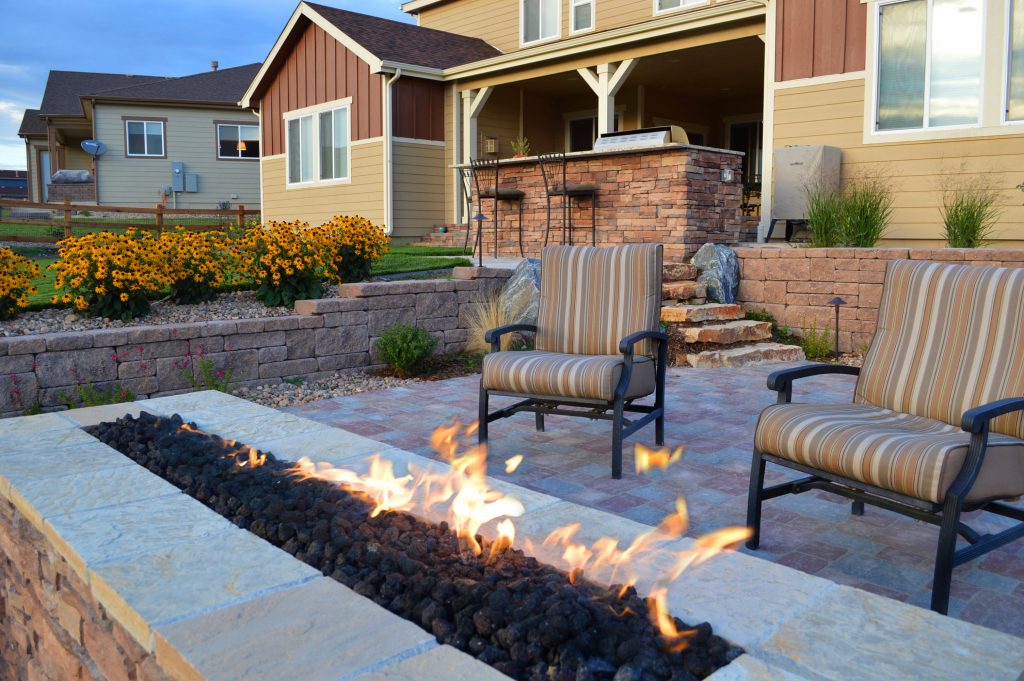
The view from the back of the lot toward the house and outdoor kitchen
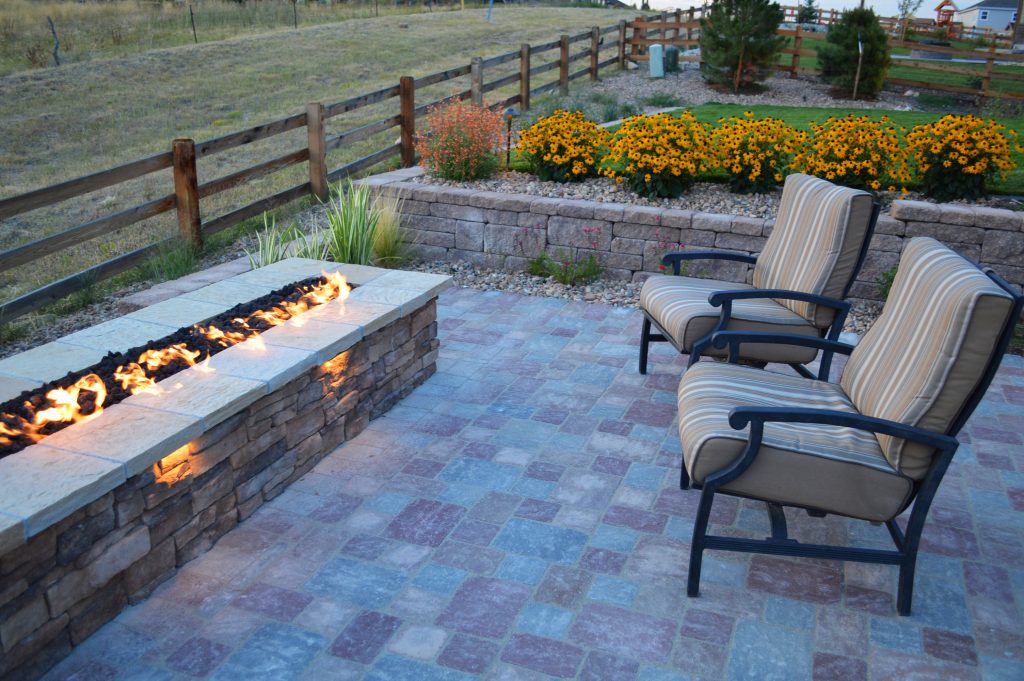
View of firepit with tiered lawn behind
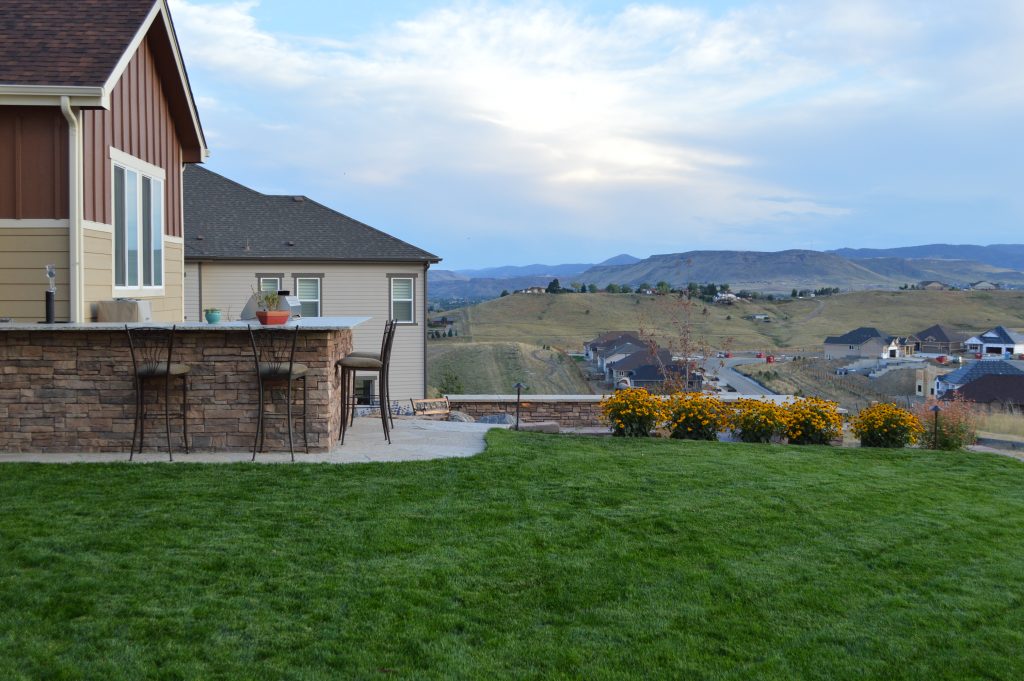
The view from the leveled-off lawn are to the outdoor kitchen
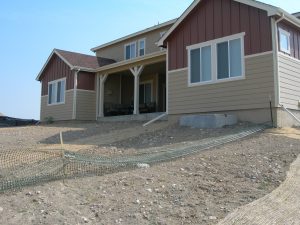
The existing sloped backyard
Most builders will include a basic front yard landscape in the home price, but will leave the back yard as bare ground for you to improve however you wish. The design must be approved by the homeowners association. The proposed landscape will need to ensure proper drainage and shouldn’t have any negative impacts on your neighbors lots, or adjacent open space.
The front yard can always be redesigned as well. The front yard irrigation mainline and valves should already be in place, so the design can be modified pretty easily. This homeowner asked us to redesign the front yard simultaneously, and they plan to redo the front yard in a second phase. For the time being, they have completed their landscape, eliminating the bare dirt and allowing them to fully enjoy their new home and yard.
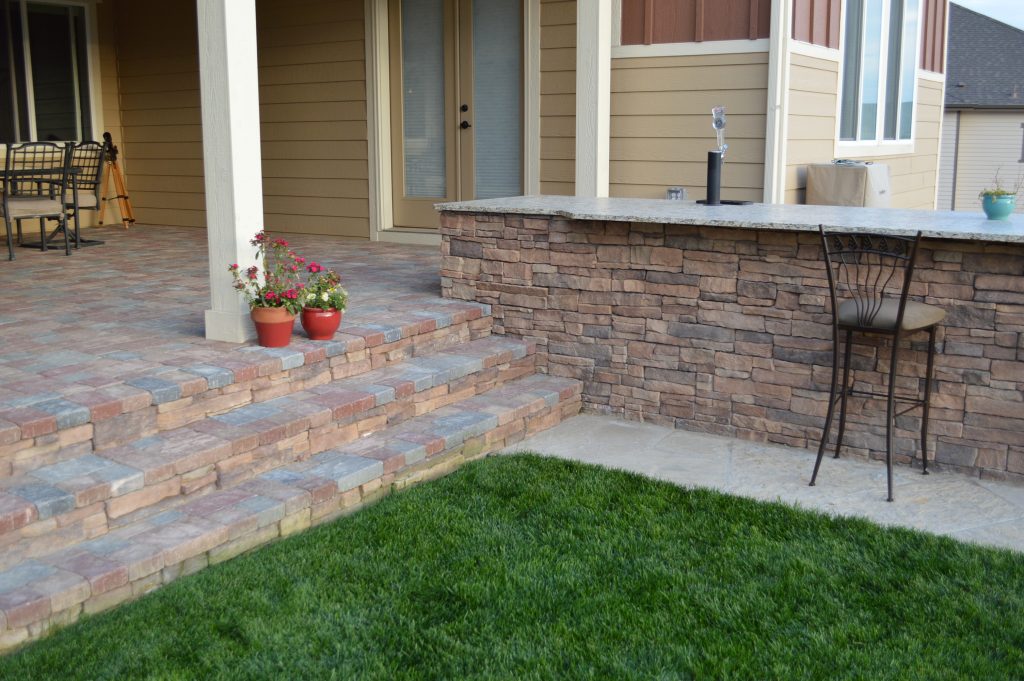
Pavers were installed over the concrete patio that came with the home
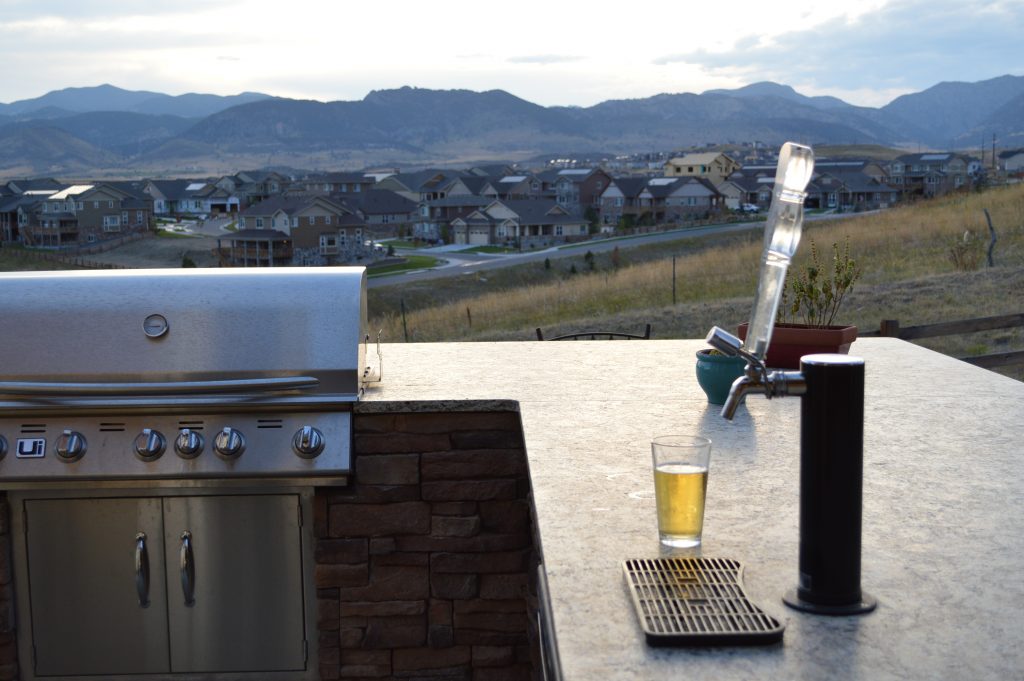
Enjoying a beer and the mountain views
This is the official blog of Outdoor Design Group, Colorado Landscape Architects. For more information about our business and our services, click here.
Related Posts:
by Todd Rutherford
As we move further into the fall season, many gardeners have turned their attention to cleaning up and preparing to put their gardens to bed for winter. Gardeners should also take this time to plan ahead for spring blooming bulbs which are currently available in your local garden center. Now is the perfect time to add these must-have jewels to your landscape. For most areas in Colorado, you should plant these bulbs sometime between the middle of September to the end of October. I have planted bulbs as late as November during a mild fall and winter. As long as the ground is not frozen, you can plant bulbs. However, by planting in early fall you give the bulbs time to establish some roots before the soil freezes, ensuring the best success. Lucky for us, the growing conditions in much of Colorado are perfect for spring blooming bulbs. The climate and ecological conditions of many of the bulb’s native ranges are quite similar to our high plains region.
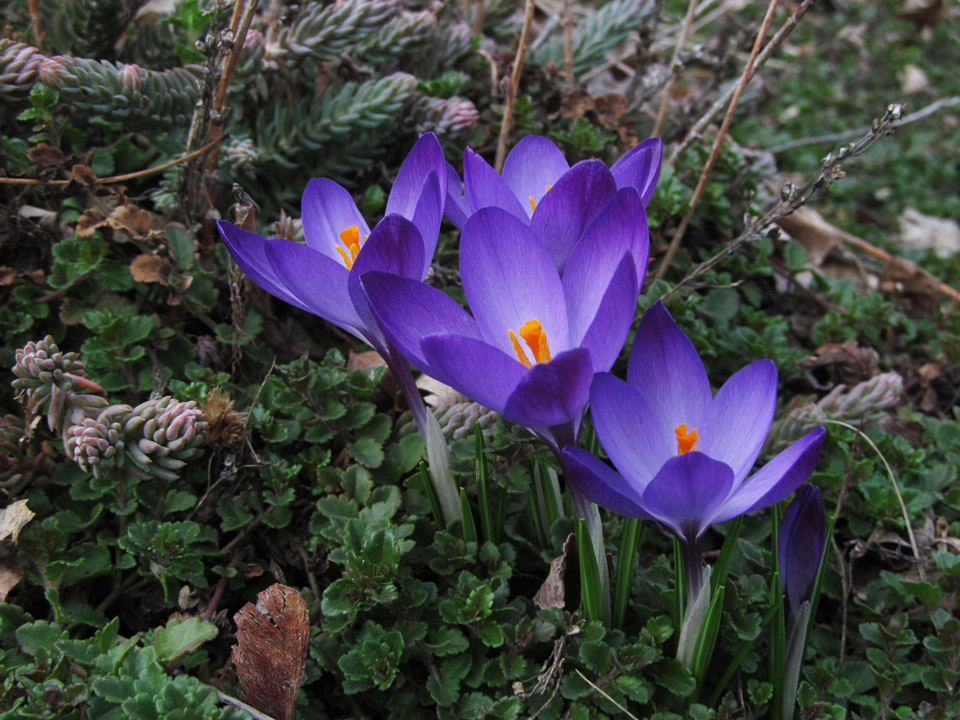
Crocus popping up through veronica and sedums.
The diversity of size, shape and color of spring blooming bulbs is fascinating. Some of the best bulbs to plant in our area are (listed in order of bloom time) :
Early Spring Bloomers: crocus, Siberian squill, snowdrops, dwarf iris, and species tulips
Mid-Spring Bloomers: hyacinths, daffodils, grape muscari, fritillaria and tulips
Late Spring Bloomers: alliums, irises and fox-tail lillies
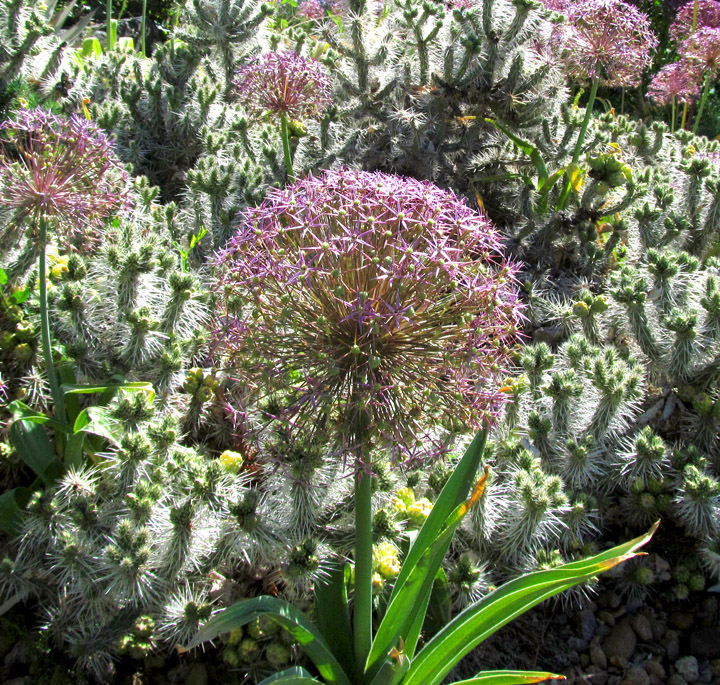
Alliums with Cholla cactus.
Fall planted bulbs do best in soils that are well drained. If the soil is too wet, the bulbs may rot. The rule of thumb is to plant the bulbs at a depth 3 to 4 times the length of the bulbs. If you buy bulbs in a package, a visual guide to bulb planting depth is usually printed on the package.
Consider adding “bulb food” to the holes you’ve dug before you drop in the bulbs. Phosphorus fertilizer will give your bulbs a boost, and help them become established. Traditionally a product called “bone meal” was recommended for providing phosphorus to bulbs. But research done at Colorado State University has shown that product doesn’t work well in our typically alkaline soil chemistry. Consider a conventional (a.k.a. “non-organic”) fertilizer called “triple super phosphate”. However, using phosphorus from conventional fertilizers has been linked to environmental damage such as toxic algae blooms in lakes and rivers. Use the conventional phosphorus sparingly and carefully. If you’ve not already done so, amending your soil with compost is also a good idea to improve soil texture for your bulbs.
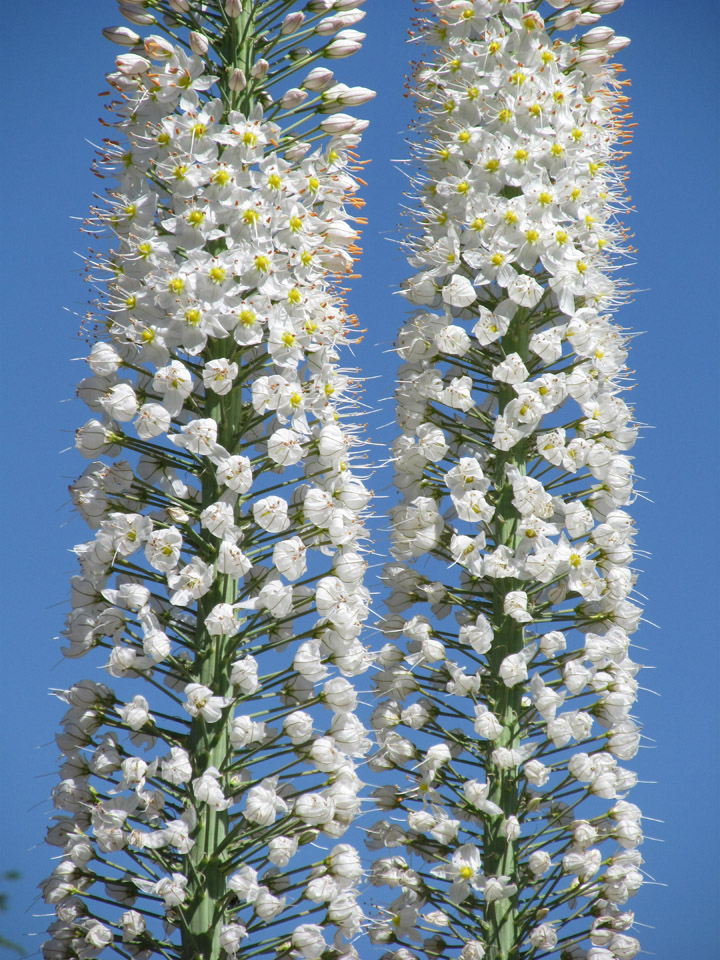
Close up of foxtail lillies.
Most spring blooming bulbs do best in full sun to part sun locations as opposed to deep shade. But if the site is south facing in full sun, that area’s soil may warm up too much in late winter, causing the bulbs to flower early and those blooms would be susceptible to frost damage during cold snaps. It is a good idea to mulch the soil where you’ve planted the bulbs. Mulch will keep the soil from drying out, and help moderate soil temperature so it doesn’t warm up too quickly.
Design-wise, you can tuck just a few bulbs into niches between established perennials and ornamental grasses in your garden, or you could add large groupings of one type of bulb to get maximum color punch in your landscape. One effective way to add bulbs to an existing garden is to place them around low-growing plants that will still be dormant when the spring bulbs emerge. That approach is particularly effective with low growing groundcover perennials. Some people will add early spring bulbs such as crocus or snowdrops to a lawn area, knowing that the grass won’t start growing or need a mowing until after the bulbs are done. And if you want to add bulbs year after year, you might want to make a plan or take photos of where the existing bulbs are when they are blooming. That way you can avoid disturbing the established bulbs next time you add more in the fall.
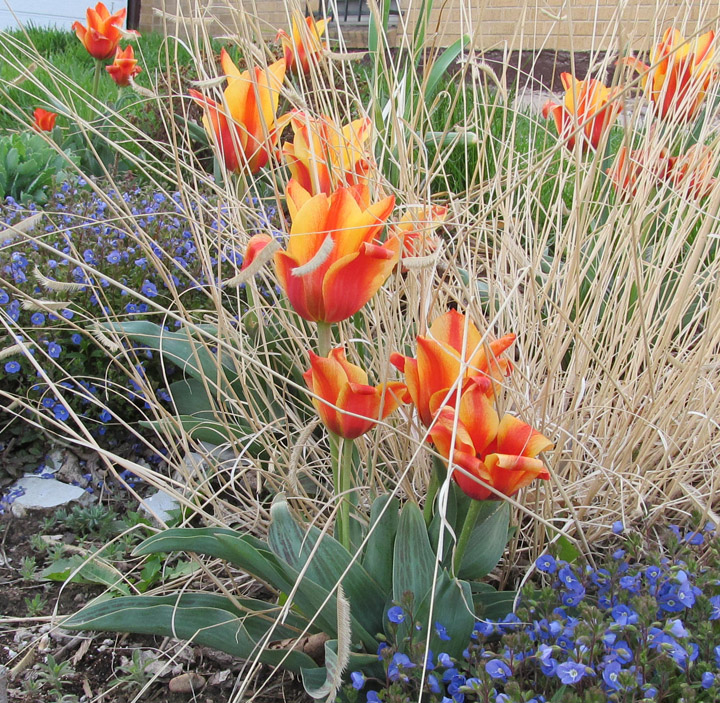
Tulips mingling with veronica and the remnants of last year’s ornamental grass.
For all the bulbs, you should not remove the leaves after the flowers have faded, until the leaves have turned from green to brown. Removing green leaves too early deprives the bulbs the ability to feed themselves in preparation for the next year’s blooms.
If your bulbs are “happy” where you’ve placed them, there’s a chance they will supply you with gorgeous blooms for many years. Adding spring blooming bulbs to your garden is an easy way to get dependable spots of color into your landscape for a springtime show!
This is the official blog of Outdoor Design Group, Colorado Landscape Architects. For more information about our business and our services, click here.
Related Posts:
by Todd Rutherford
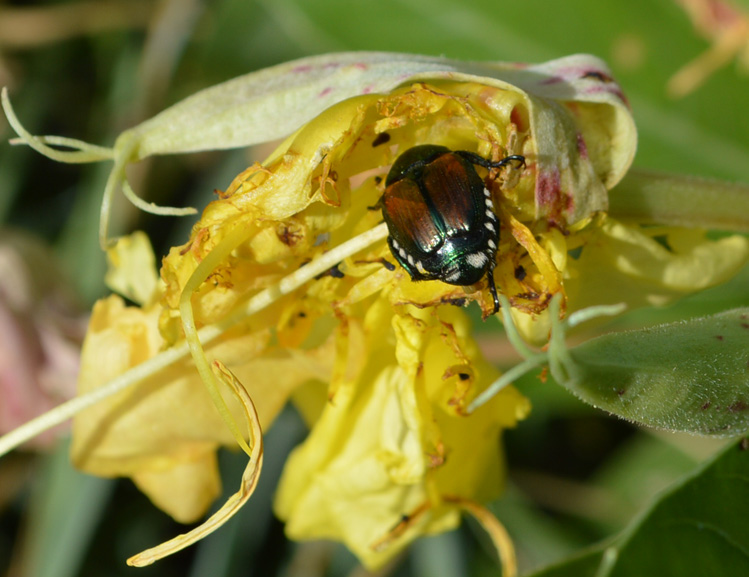
Japanese beetle eating an Oenothera flower at the Denver Botanic Gardens.
Gardeners around Colorado’s Front Range are coming face to face with a new foe in our landscapes. Japanese beetles have been a pest for years in U.S. gardens in the east, south and mid-west. It is only relatively recently that the feared invasive pest has made its presence known in Colorado.
The beetles (Popillia japonica) are believed to have entered North America via New Jersey in 1916, probably hitchhiking on ornamental nursery stock from Asia. They are voracious feeders, doing damage to trees, shrubs, perennials, annuals and turf grass. Some of the 300 favorite food plants of the adult Japanese beetles are roses, Virginia creeper, grape vines, raspberries, linden, elm and fruit trees. The sign of their destruction is skeletonized foliage and flower petals that have been devoured. The adult beetles feed during the day, preferring hot and sunny days.
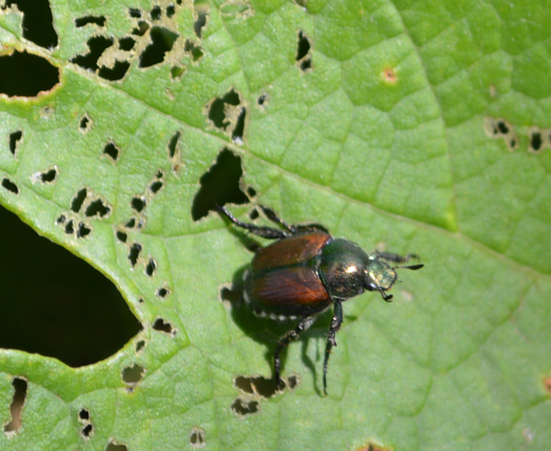
Japanese beetle on a “skeletonized” grape leaf at the Denver Botanic Gardens.
The beetle’s one-year life cycle seems tailor made for a traditional lush turf and shrub landscape. They spend winter underground as a grub, feeding on turf grass roots, creating dead patches in the lawn. In June they begin to emerge as adults ready to feed on the flowers and leaves of plants. The adults can be found feeding on plants as late as September. In addition to feeding on your landscape plants, they might be seen mating on those plants. After mating, females will move to turf grass lawns to dig into the soil to deposit their eggs. After depositing eggs, the females will resume feeding on host plants. The females will return to the lawn to lay more eggs. Up to 60 eggs can be laid by each female beetle during her 4-8 week life span.
Back in the turf grass soil, the eggs will hatch and the Japanese beetle larvae will emerge and move to the grass roots to feed. The larvae are most susceptible to drying out and dying when young if the soil dries out. That is one reason some experts advise against over watering lawns in mid to late summer. The larvae will develop rapidly, causing much damage to the turf grass roots, eventually killing some of the turf grass plants. The larvae feed on the grass roots until the temperature drops below 60 degree F. The larvae move deeper down into the soil to overwinter. Once the soil warms up in spring, the larvae move back up through the soil to resume feeding on the grass roots for about 4 to 6 weeks. After that, they begin to pupate. A couple weeks after pupation, the adults will emerge from the soil to feed on leaves and flowers, mate and start the cycle all over.
The worst damage caused by the Japanese beetles seems to be to lawns, where the larvae can cause dead patches. It appears the damage to shrubs and trees is mostly cosmetic, and will not kill those plants. However, this cosmetic damage can be significant and will upset most gardeners.
Unfortunately there is no magic bullet to control Japanese beetles in your landscape. If you discover them when they first arrive, using manual methods to collect them is a wise choice. Do not crush them, or the chemicals released upon squishing will attract more Japanese beetles to your yard. Try collecting them in a jar of soapy water. Traps are not recommended because they also attract more beetles to your yard. Pesticides may be effective at controlling the beetles. However some systemic pesticides have been linked to death of beneficial pollinating insects such as bees. For more information on the safe use of pesticides and other methods to control Japanese beetles, visit the Colorado State Extension webpage on the subject. Some experts advise the application of grub killing pesticides to lawns to kill the Japanese beetle larvae and keep your turf from being destroyed. The extension does say this about trying to control the larvae of Japanese beetles: “Some cultural practices can limit damage and applied chemical or biological controls may also be useful. However, control of Japanese beetle larvae in a yard will have very little, if any, effect on the number of Japanese beetle adults feeding on trees, shrubs and garden plants. The insect is highly mobile so that problems with adult beetles typically involve insects that have moved a considerable distance.”
As mentioned earlier, dry turf soil during the egg laying season (mostly in June & July) will keep some larvae from surviving to become adults. Some experts recommend drying out your lawn and letting it go dormant during the typical Japanese beetle egg laying time, and resuming watering after the eggs have been layed. This would seem a challenging approach to the problem as most people prefer a green, non-dormant lawn during the time of year when a lush lawn is much desired. The extension service does recommend that keeping lawns well watered after egg laying (and once the older larvae are present and most actively feeding) may help the turf survive root injuries caused by larval feeding.
It would appear that typical xeriscape plants are not usually favored by the beetles. This is yet another reason that a xeric and regionally appropriate landscape design is a good approach to follow in Denver and Colorado in general.
Let’s hope we can keep this exotic and invasive pest at bay, and not let it become an established nuisance.
This is the official blog of Outdoor Design Group, Colorado Landscape Architects. For more information about our business and our services, click here.
Related Posts:
by Todd Rutherford
Starting on August 10, 2016, it is no longer illegal for homeowners to collect the rain (or other precipitation) that has fallen on their roofs. In May 2016 Governor John Hickenlooper signed a law (House Bill 16-1005) that allows residential properties and multifamily residences with four or fewer units to use up to two rain barrels, located above ground, with a combined storage capacity of 110 gallons.
Rain barrels can only collect precipitation from rooftop downspouts, and the collected water can only be used on the same property from where it was gathered. The collected water can only be used for outdoor purposes, such as watering outdoor plants. Collected water in rain barrels can not legally be used for drinking or indoor uses. Additionally, it should be known by rain barrel owners that operating a rain barrel does not constitute a water right. There is language in the bill that the State Engineer “may curtail rain barrel usage” if a water right holder can prove that the use of rain barrels has impacted their ability to receive their entitled water. In fact, in the bill it says the State Engineer must report to agricultural committees in the legislature in the year 2019 and 2022, on “whether the allowance of small-scale residential precipitation collection pursuant to this article has caused any discernible injury to downstream water rights.”
If you would like to learn more about rain barrels. check out Colorado State University Extension for more information.
This is the official blog of Outdoor Design Group, Colorado Landscape Architects. For more information about our business and our services, click here.
Related Posts:
by Todd Rutherford
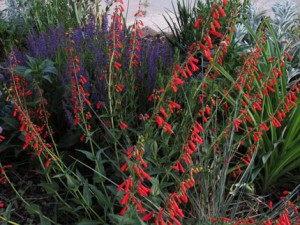
I took this photo of a Firecracker Penstemon (Penstemon eatonii) in my garden back in early June. We here in the Denver area were enjoying spring like weather at the time, and so the vivid red blooms of this beauty were still captivating the pedestrians in my neighborhood who passed it by. Despite its namesake, these blooms do not make it to July 4th, as this plant usually begins flowering in early to mid Spring. Behind the penstemon, you can see a blue salvia providing a lovely blue-purple counter note to the penstemon’s brilliant warm red. This particular plant is looking a little leggy. The bed where it resides gets a bit more moisture than the plant should be receiving. It is my understanding that many (if not most) of the penstemons do better on the drier side. For useful information on how best to care for penstemons, please see the list of penstemon growing tips on the High Country Gardens website. One characteristic I appreciate about Firecracker Penstemon is the foliage can be evergreen throughout our Denver winters. And, if you have hummingbirds visiting your yard, they might be happily feeding on the tubular flowers this gorgeous plant produces.
I started this plant indoors, from seed. Many of the penstemons are very easy to acquire this way. This ease of starting from seed obviously translates to the the plants reseeding themselves in the garden. However, I find they are only mild re-seeders, and not nuisance re-seeders like lamb’s ear or blanket flower.
I highly recommend you add a splash of red to your landscape with Firecracker Penstemon. If red is not the color you are after, there are several other penstemon species and hybrids to choose from that offer diverse flower colors on plants that are perfect for low-water landscapes.
This is the official blog of Outdoor Design Group, Colorado Landscape Architects. For more information about our business and our services, click here.
Related Posts:













